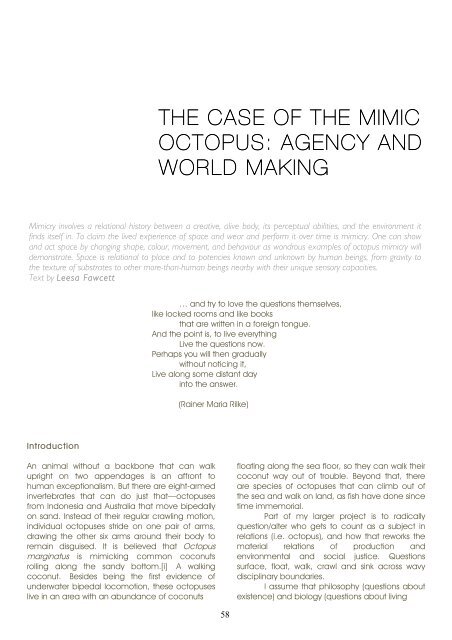Animal Influence I - Antennae The Journal of Nature in Visual Culture
Animal Influence I - Antennae The Journal of Nature in Visual Culture
Animal Influence I - Antennae The Journal of Nature in Visual Culture
Create successful ePaper yourself
Turn your PDF publications into a flip-book with our unique Google optimized e-Paper software.
Introduction<br />
An animal without a backbone that can walk<br />
upright on two appendages is an affront to<br />
human exceptionalism. But there are eight-armed<br />
<strong>in</strong>vertebrates that can do just that—octopuses<br />
from Indonesia and Australia that move bipedally<br />
on sand. Instead <strong>of</strong> their regular crawl<strong>in</strong>g motion,<br />
<strong>in</strong>dividual octopuses stride on one pair <strong>of</strong> arms,<br />
draw<strong>in</strong>g the other six arms around their body to<br />
rema<strong>in</strong> disguised. It is believed that Octopus<br />
marg<strong>in</strong>atus is mimick<strong>in</strong>g common coconuts<br />
roll<strong>in</strong>g along the sandy bottom.[i] A walk<strong>in</strong>g<br />
coconut. Besides be<strong>in</strong>g the first evidence <strong>of</strong><br />
underwater bipedal locomotion, these octopuses<br />
live <strong>in</strong> an area with an abundance <strong>of</strong> coconuts<br />
THE CASE OF THE MIMIC<br />
OCTOPUS: AGENCY AND<br />
WORLD MAKING<br />
Mimicry <strong>in</strong>volves a relational history between a creative, alive body, its perceptual abilities, and the environment it<br />
f<strong>in</strong>ds itself <strong>in</strong>. To claim the lived experience <strong>of</strong> space and wear and perform it over time is mimicry. One can show<br />
and act space by chang<strong>in</strong>g shape, colour, movement, and behaviour as wondrous examples <strong>of</strong> octopus mimicry will<br />
demonstrate. Space is relational to place and to potencies known and unknown by human be<strong>in</strong>gs, from gravity to<br />
the texture <strong>of</strong> substrates to other more-than-human be<strong>in</strong>gs nearby with their unique sensory capacities.<br />
Text by Leesa Fawcett<br />
… and try to love the questions themselves,<br />
like locked rooms and like books<br />
that are written <strong>in</strong> a foreign tongue.<br />
And the po<strong>in</strong>t is, to live everyth<strong>in</strong>g<br />
Live the questions now.<br />
Perhaps you will then gradually<br />
without notic<strong>in</strong>g it,<br />
Live along some distant day<br />
<strong>in</strong>to the answer.<br />
(Ra<strong>in</strong>er Maria Rilke)<br />
58<br />
float<strong>in</strong>g along the sea floor, so they can walk their<br />
coconut way out <strong>of</strong> trouble. Beyond that, there<br />
are species <strong>of</strong> octopuses that can climb out <strong>of</strong><br />
the sea and walk on land, as fish have done s<strong>in</strong>ce<br />
time immemorial.<br />
Part <strong>of</strong> my larger project is to radically<br />
question/alter who gets to count as a subject <strong>in</strong><br />
relations (i.e. octopus), and how that reworks the<br />
material relations <strong>of</strong> production and<br />
environmental and social justice. Questions<br />
surface, float, walk, crawl and s<strong>in</strong>k across wavy<br />
discipl<strong>in</strong>ary boundaries.<br />
I assume that philosophy (questions about<br />
existence) and biology (questions about liv<strong>in</strong>g












